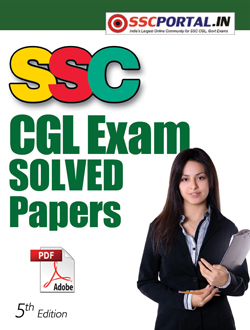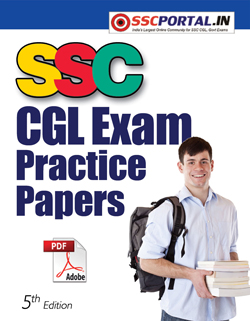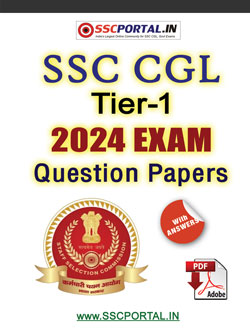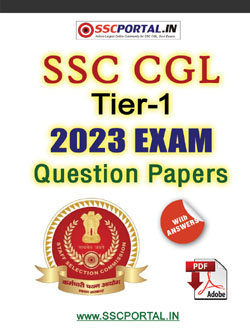NEW! SSC CGL PDF NOTES
SSC CGL (Tier - 1) Exam Solved Paper - 2011 "Numerical Aptitude" (1st shift)
SSC CGL (Tier - 1) Exam Solved Paper - 2011 "Numerical Aptitude" (1st shift)
Subject: Numerical Aptitude
1.

(a) 5
(b) 7
(c) 123
(d) 125
2.

(a) 2
(b) 4
(c) 16
(d) (136)1/3
3. I multiplied a natural number by 18 and another by 21 and added the products. Which one of the following could be the sum?
(a) 2007
(b) 2008
(c) 2006
(d) 2002
4. The product of two numbers is 45 and their difference is 4. The sum of squares of the two numbers is
(a) 135
(b) 240
(c) 73
(d) 106
5.

(a) 4
(b) 6
(c) 8
(d) 10
6.

7. When 2 31 is divided by 5 the remainder is
(a) 4
(b) 3
(c) 2
(d) 1
8.
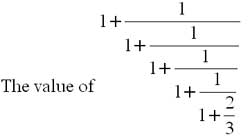
(a) 21/13
(b) 17/3
(c) 34/21
(d) 8/5
9. The unit digit in the product (122) 173 is
(a) 2
(b) 4
(c) 6
(d) 8
10.
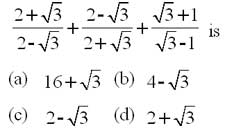
11. If a * b = 2a + 3b – ab, then the value of (3 * 5 + 5 * 3) is
(a) 10
(b) 6
(c) 4
(d) 2
12. Simplify:

(a) 0.9306
(b) 1.0009
(c) 1.0050
(d) 15
13.
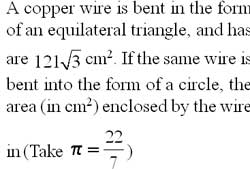
(a) 364.5
(b) 693.5
(c) 346.5
(d) 639.5
14. A child reshapes a cone made up of clay of height 24 and radius 6cm into a sphere. The radius (in cm) of eh sphere is
(a) 6
(b) 12
(c) 24
(d) 48
15. Water flows into a tank which is 200m long and 150m wide, through a pipe of cross-section 0.3m × 0.2m at 20 km/hour. Then the time (in hour) for the water level in the tank to reach 8cm is
(a) 50
(b) 120
(c) 150
(d) 200
16. The product of two numbers is 2028 and their H.C.F. is 13. The number of such pairs is
(a) 1
(b) 2
(c) 3
(d) 4
17. Two equal vessels are filled with the mixture of water and milk in the ratio of 3:4 and 5:3 respectively. If the mixtures are poured into a third vessel, the ratio of water and milk in the third vessel will be
(a) 15 : 12
(b) 53 : 59
(c) 20 : 9
(d) 59 : 53
18. I am three times as old as my son. 15 years hence, I will by twice as old as my son. The sum of our ages is
(a) 48 years
(b) 60 years
(c) 64 years
(d) 72 years
19. Three bells ring simultaneously at 11 a.m. They ring at regular intervals of 20 minutes, 30 minutes, 40 minutes respectively. The time when all the three ring together next is
(a) 2 p.m.
(b) 1 p.m.
(c) 1.15 p.m.
(d) 1.30 p.m.
20. A and B together can do a works in 12 days. B and C together do it in 15 days. If A’s efficiency is twice that of C, then the days required for B alone to finish the work is
(a) 60
(b) 30
(c) 15
(d) 15
21. A and B can do a work in 12 days, B and C can do the same work in 15 days, C and A can do the same time work in 20 days. The time taken by A, B and C to do the same work is
(a) 5 days
(b) 10 days
(c) 15 days
(d) 20 days
22. A is 50% as efficient as B. C does half of the work done by A and B together. If C alone does the work in 20 days, then A, B and C together can do the work in
(a) 17/3days
(b) 20/3days
(c) 6 days
(d) 7 days
23. The ratio of the volumes of water and glycerine in 240cc of a mixture is 1 : 3. The quantity of water (in cc) that should be added to the mixture so that the new ratio of the volume of water and glycerine becomes 2:3 is
(a) 55
(b) 60
(c) 62.5
(d) 64
24. At present, the ratio of the ages of Maya and Chhaya is 6:5 and fifteen years from now, the ratio will get changed to 9:8. Maya’s present age is
(a) 21 years
(b) 24 years
(c) 30 years
(d) 40 years
25. The ratio of the income to the expenditure of a family is 10:7. If the family’s expenses are Rs. 10,500, then savings of the family is
(a) Rs. 4,500
(b) Rs. 10,000
(c) Rs. 4,000
(d) Rs. 5,000
26. The average mathematics marks of two Sections A and B of Class IX in the annual examination is 74. The average marks of Section A is 77.5 and that of Section B is 70. The ratio of the number of students of Section A and B
(a) 7 : 8
(b) 7 : 5
(c) 8 : 7
(d) 8 : 5
27. The average weight of a group of 20 boys was calculated to be 89.4 kg and it was later discovered that one weight was misread as 78kg instead of 87 kg. The correct average weight is
(a) 88.95 kg
(b) 89.25 kg
(c) 89.55 kg
(d) 86.85 Kg
28. The diameter of a wheel is 98 cm. The number of revolutions in which it will have to cover a distance of 1540 m is
(a) 500
(b) 600
(c) 700
(d) 800
129. In an equilateral triangle ABC of side 10cm, the side BC is trisected at D. Then the length (in cm) of AD is
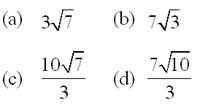
30. The cost price of an article is Rs. 800. After allowing a discount of 10%, a gain of 12.5% was made. Then the marked price of the article is
(a) Rs. 1,000
(b) Rs. 1,100
(c) Rs. 1,200
(d) Rs. 1,300
31. A man bought an article listed at Rs. 500 with a discount of 20% offered on the list price. What additional discount must be offered to man to bring the net price to Rs. 1,104?
(a) 8%
(b) 10%
(c) 12%
(d) 15%
32.
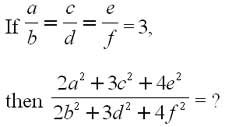
(a) 2
(b) 3
(c) 4
(d) 9
33. The floor of a room is of size 4m × 3m and its height is 3m. The walls and ceiling of the room require painting. The area to be painted is
(a) 66 m 2
(b) 54 m 2
(c) 43 m 2
(d) 33 m 2
34. When the price of an article was reduced by 20% its sale increased by 80%. What was the net effect on the sale?
(a) 44% increase
(b) 44% decrease
(c) 66% increase
(d) 66% decrease
35. The price of sugar goes up by 20%. If a housewife wants the expenses on sugar to remain the same, she should reduce the consumption by
(a) 76/5%
(b) 41/3%
(c) 20%
(d) 25%
36. In a factory 60% of the workers are above 30 years and of these 75% are males and the rest are females. If there are 1350 male workers above 30 years, the total number of workers in the factory
(a) 3000
(b) 2000
(c) 1800
(d) 1500
37.

38. The selling price of 10 oranges is the cost price of 13 oranges. Then the profit percentage is
(a) 30%
(b) 10%
(c) 13%
(d) 3%
39. The marked price of a ratio is Rs. 480. The shopkeeper allows a discount at 10% and gains 8%. If no discount is allowed, his gain percent would be
(a) 18%
(b) 18.5%
(c) 20.5%
(d) 20%
40. A man sold 20 apples for Rs. 1000 and gained 20%. How many apples did he buy for Rs. 100?
(a) 20
(b) 22
(c) 24
(d) 25
41. A rectangular sheet of metal is 40 cm by 15 cm. Equal squares of side 4 cm are cut off at the corners and the remainder is folded up to form an open rectangular box. The volume of the box is
(a) 896 cm 3
(b) 986 cm 3
(c) 600 cm 3
(d) 916 cm 3
42.
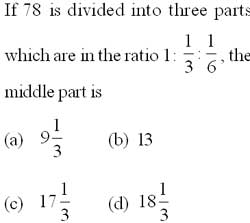
43. The simple interest on a sum of money is 1/9of the principle and the number of years is equal to rate per cent annum. The rate per annum is
(a) 3%
(b) 1/3%
(c) 10/3%
(d) 3/10%
44. The difference between simple interest and compound interest of a certain sum of money at 20% per annum for 2 years is Rs. 48. Then the sum is
(a) Rs. 1,000
(b) Rs. 1,200
(c) Rs. 1,500
(d) Rs. 2,000
45. Shri X goes to his office by scooter at a speed of 30 km/h and reaches 6 minutes earlier. If he goes at a speed of 24 km/h, he reaches 5 minutes late. The distance of his office is
(a) 20 km
(b) 21 km
(c) 22 km
(d) 24 km
46. A sum of money becomes eight times in 3 years, if the rate is compounded annually. In how much time will the same amount at the same compound rate become sixteen times?
(a) 6 years
(b) 4 years
(c) 8 years
(d) 5 years
Directions (47-50): The pie chart given below show the spending of a family on various heads during a month. Study the graph and answer the questions 147 to 150.
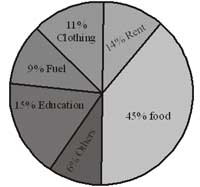
47. If the total income of the family is Rs. 25,000, then the amount spent on Rent and Food together is
(a) Rs. 17,250
(b) Rs. 14,750
(c) Rs. 11,250
(d) Rs. 8,500
48. What is the ratio of the expenses of Education to the expenses on Food?
(a) 1 : 3
(b) 3 : 1
(c) 3 : 5
(d) 5 : 3
49. Expenditure on Rent is what percent of expenditure of Fuel?
(a) 135%
(b) 156%
(c) 167%
(d) 172%
50. Which three expenditures together have a central angle of 108o?
(a) Fuel, Clothing and Others
(b) Fuel, Education and Others
(c) Clothing, Rend and Others
(d) Education, Rent and Others
Answer Key
| 1.d | 6.b | 11.a | 16.b | 21.b | 26.a | 31.a | 36a. | 41a | 46.b |
| 2.b | 7.b | 12.d | 17.d | 22.b | 27.d | 32.d | 37.a | 42.c | 47.b |
| 3.a | 8.c | 13.c | 18.b | 23.b | 28.a | 33.b | 38.a | 43.c | 48.a |
| 4.d | 9.b | 14.a | 19.b | 24.c | 29.c | 34.a | 39.d | 44.b | 49.b |
| 5.a | 10.a | 15.d | 20.c | 25.a | 30.a | 35.b | 40.c | 45.c | 50.b |




